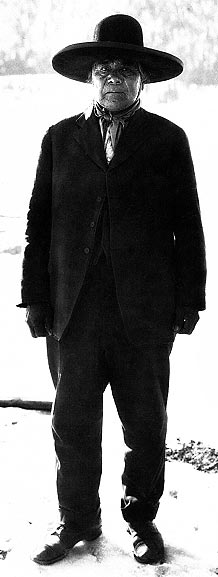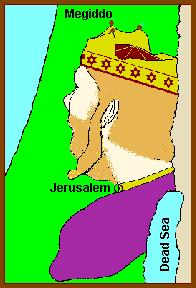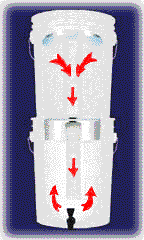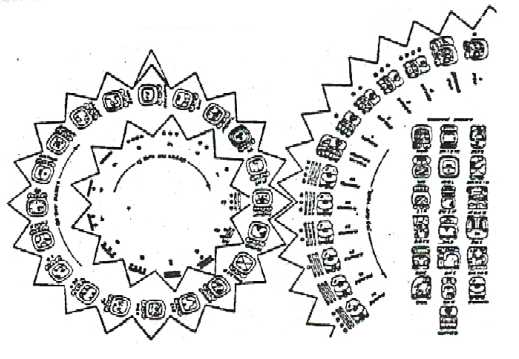THE OLMEC
ENIGMA: ASTRONAUT CORROBORATES
SITCHIN
If an astronaut were ever to corroborate an aspect of my writings,
I would have expected it to be in regard to planetary
matters. Surprisingly, such a corroboration concerns, of all things,
the Olmecs of ancient Mexico.
The unexpected corroboration is
tucked away in the recently published book A Leap of Faith by the
Mercury-7 astronaut Gordon Cooper, in which his story as a test pilot and
astronaut is peppered with (to quote from the dust jacket) "his strong views
on the existence of extraterrestrial intelligence -- and even the distinct
possibility that we have already had contact."
The Olmec
Enigma
|
Readers of my books, and especially of The Lost Realms,
as well as of a previous article on this website titled
"The Case of the Missing
Elephant," know by now that beginning with the discovery of a
colossal stone head in 1869, an advanced civilization that preceded the Mayas
and Aztecs of Mexico came to light.
Its leaders and bearers were unmistakably black
Africans. They were arbitrarily
named by archaeologists "Olmecs"; and their embarrassing enigma -- of who
they were, and how they had come across the ocean, and why, was compounded
by the timing of their arrival in the New World.
Once it was conceded (very grudgingly!) that the 'Olmecs' did indeed represent
the earliest or even Mother Civilization of Mesoamerica, the date of their
arrival was at first set at about 250 B.C.; then at about 500 B.C.; then
farther back and back, until 1500 B.C. was acknowledged.
But I have argued for a date twice as old!
|
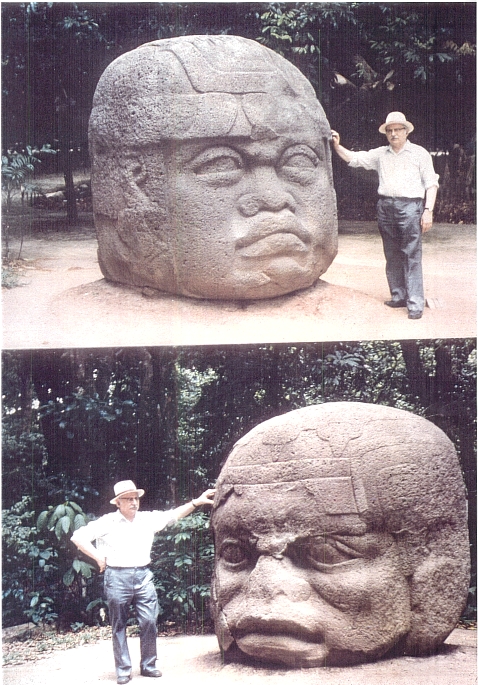 |
A God and His Secret Number
My conclusion that the Olmec presence in the New World went back
at least 5,000 years, to circa 3000 B.C., was reached by many
paths. The first one was an
attempt to identify the great god of Mesoamerica, the Winged Serpent
(Quetzalcoatl to the Aztecs, Kukulkan to the Mayas), and the significance
of his promise to return to those lands on the first day of a 52-year cycle,
(AD 1519, when the Aztec king Montezuma believed that the appearance of the
Spanish conquistador Cortez was such a Return, coincided with the anticipated
sacred date).
The peoples of Mesoamerica employed in addition to a practical
calendar of 365 days, called the Haab, also a Sacred Calendar (called
Tzolkin) of 260 days. The
two cyclical calendars were conceived as two wheels with meshing teeth that
turned and returned to the same spot once in 52 years; and 52 was the Sacred
Number of the Winged Serpent god?
Since 52 was also the Secret Number of the god known to the Egyptians
as Thoth; since Thoth as Quetzalcoatl, was the god of science and
the calendar; and since Thoth was exiled from Egypt circa 3100 B.C., I have
suggested that it was he who took a group of his African followers to a new
land, bringing the "Olmecs" to Mesoamerica.
Accordingly, I said, Olmec presence goes back to at least 3000
B.C. -- a date twice as old as that conceded by established
archaeologists.
The Mysterious "Day One"
By the time I was writing The Lost Realms, the book devoted
to the prehistory of the Americas, I was sure that the arrival of the Olmecs
with Thoth/Quetzalcoatl could be established with astounding
precision. The key to unlocking the enigma was the Olmec
Calendar.
|
In addition to the Haab and the Tzolkin, there was in Mesoamerica
a third calendar, used to inscribe dates on
monuments. Given the name the
Long Count, it was not cyclical as the other two, but linear -- a
continuous one, counting the total number of days that had passed since the
counting began on a mysterious Day One.
By means of glyphs denoting groups of days
(1, 20, 360, 7,200 or even 144,000) and dots
and bars giving the number for each group-glyph, monuments were dated by
saying: A total of so many days from Day One have passed when this Monument
was erected.
But what was that Day One, when did it occur, and what was its
significance?
It has been established beyond doubt that this Long Count calendar
was the original Olmec calendar; and it is now generally agreed that Day
One was equivalent to August 13, 3113 B.C.
But what does that date
signify? As far as I know, the
only plausible answer was provided by me: It was the date of Thoth/Quetzalcoatl's
arrival, with his followers in Mesoamerica! |
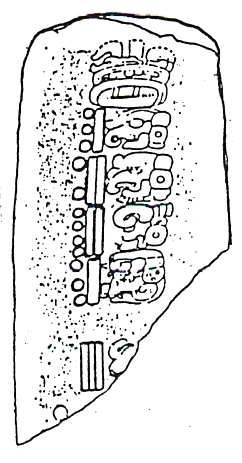 |
The Unexpected Corroboration
All official publications continue, however, to remain at 1250
B.C. -- 1500 B.C. at most -- as the date of the start of the Olmec
presence.
Imagine my pleasant surprise to come across an eye-witness report
by the astronaut Gordon Cooper in chapter 11 of his book A Leap of
Faith. "During my final
years with NASA," he writes, "I became involved in a different kind of adventure:
undersea treasure hunting in Mexico." One day, accompanied by a National
Geographic photographer, they landed in a small plane on an island in
the Gulf of Mexico; local residents pointed out to them pyramid-shaped mounds,
where they found ruins, artifacts and
bones. On examination back in
Texas, the artifacts were determined to be 5,000 years
old!
"When we learned of the age of the artifacts," Cooper writes,
“we realized that what we'd found had nothing to do with seventeenth-century
Spain... I contacted the Mexican government and was put in touch with the
head of the national archaeology department, Pablo Bush
Romero."
Together with Mexican archeologists the two went back to the
site. After some excavating, Cooper writes,
"The age of the ruins was confirmed:
3000 B.C. Compared with other advanced civilizations, relatively little was
known about this one
--called
the Olmec."
Proceeding to describe some of the amazing discoveries
about the Olmecs and their achievements, Gordon Cooper continues
thus:
"Engineers, farmers, artisans, and traders, the
Olmecs had a remarkable civilization. But it is still not known where
they originated... Among the findings that intrigued me most: celestial
navigation symbols and formulas that, when translated, turned out to be
mathematical formulas used to this day for navigation, and accurate drawings
of constellations, some of which would not be officially 'discovered' until
the age of modern telescopes."
It was this, rather than his experiences as an
astronaut, that triggered Gordon Cooper's "Leap of faith": "This left me
wondering: Why have celestial navigation signs if they weren't navigating
celestially?” And he asks:
If ‘someone’ had helped the Olmecs with this knowledge, from
whom did they get it?
My readers, of course, know the answers.
Has the Cover-up Ended?
|
The outstanding museum on the
Olmec civilization in Jalapa, in the Veracruz province of Mexico, included
when it was built a wall panel showing the extent and dates of Mexico's various
cultures. On my first visit
there, I could hardly believe my eyes: The first (earliest) civilization,
that of the Olmecs, was shown as begun circa 3000 B.C.!
I urged the members of my group to take pictures of me pointing
to the date: Finally, the date claimed by me has been officially
accepted!
On a second visit, however (to which the previous article,
The Case of the Missing
Elephant relates), not only the telltale elephant-toy disappeared;
the Olmec column starting at 3000 B.C. was also gone... And the official
Museum Catalogue, reviewing the Olmec civilization, reverted to 1500
B.C.
But now comes the astronaut Gordon Cooper, and innocently and
inter-alia tells, as an eye-witness, what he was told by the chief Mexican
archaeologist: 3000 B.C. |
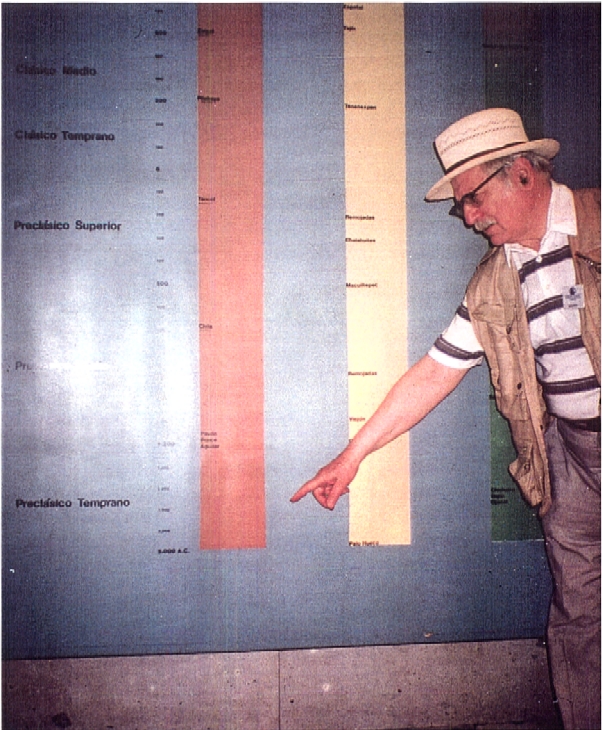 |
And thus, when all is said and done, I stand
vindicated.
Zecharia
Sitchin
November 2000
Reproduction is permitted if accompanied by the
statement:
© Z. Sitchin 2001
Reproduced by permission.


